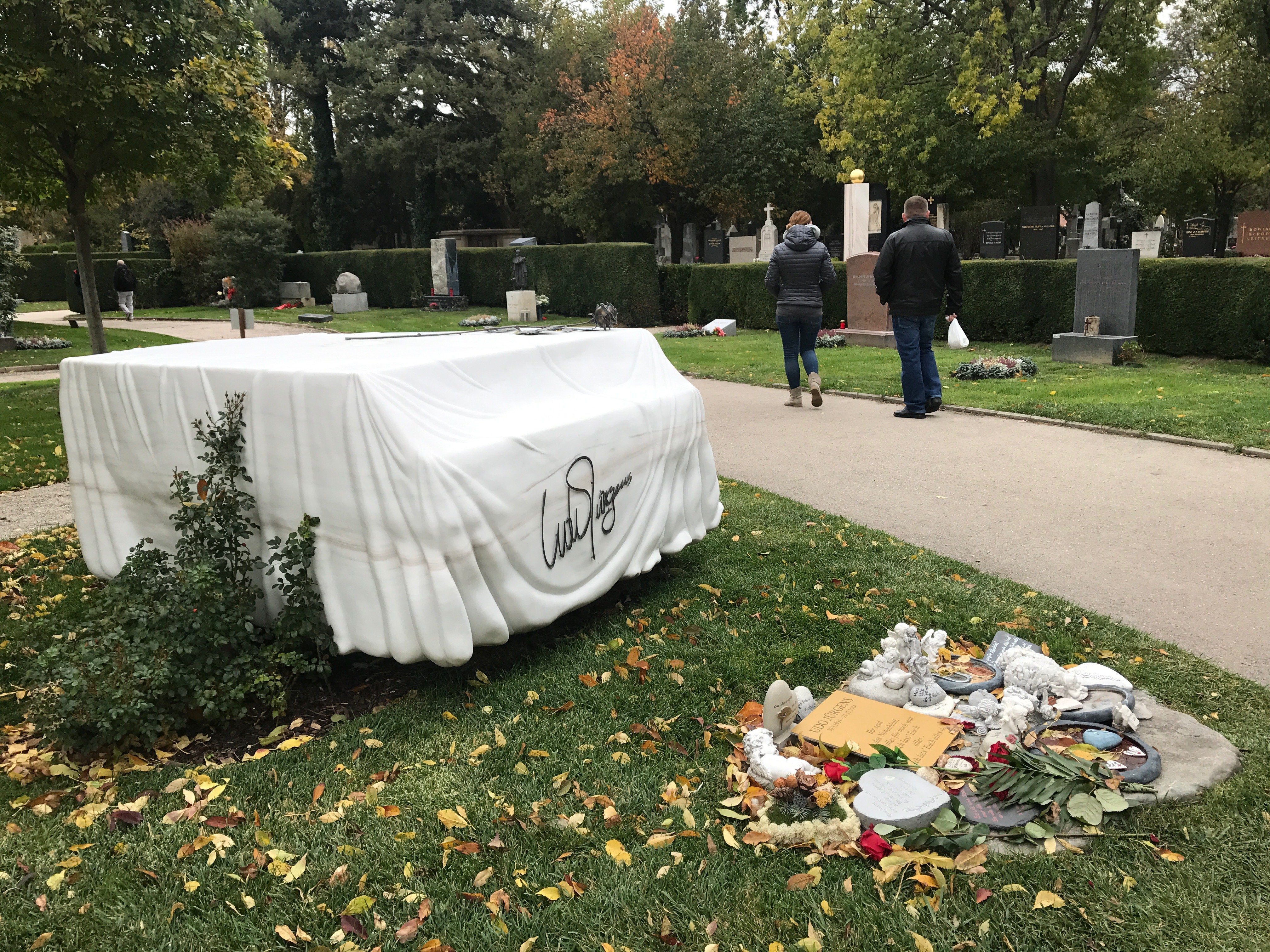
Long Live Vienna’s Central Cemetery

Long Live Vienna’s Central Cemetery
Glühwein in Simmering
According to an old Viennese joke, the city’s Central Cemetery is half the size of Zürich, but twice as fun.
It is huge. It contains 330,000 tombs, and a deceased population almost double that of Vienna’s living residents. But central, it’s not: it’s on Vienna’s southern edge, sprawled between a flat industrial quarter and the airport. Nothing says eternal peace like the dulcet tones of the 6:10 a.m. Lufthansa flight to Frankfurt.
When it opened in 1875, no one went there because its location was so inconvenient, and if there’s one thing the Viennese can’t abide, it’s inconvenience. So the authorities tried to lure visitors by beefing up the cemetery’s population of notable bodies: Beethoven and Schubert were summarily exhumed from their original resting places and rehoused in a special VIP section.
Now, there are many reasons to come here. In addition to Austrian luminaries, there is a fancy cafe. Visitors can actually drive their cars through its main arteries to get to their deceased loved ones, and tourists can hop on horse-drawn carriage rides. The cemetery appeared (twice) in The Third Man. It boasts the world’s first museum devoted to death and burial. (In Vienna’s empire heyday, holding elaborate funerals and leaving a beautiful corpse behind were the ultimate #lifegoals.) They say Vienna is obsessed with death, but I can never tell if it’s death that Vienna is obsessed with, or the past.

I grew up in Vienna, yet this is my first time here. (Did I mention it’s inconvenient? Also, the relatives of mine interred in Austrian soil—my Canadian grandfather and his brother—are at another of the city’s 46 cemeteries.)
I park outside of gate 2, one of the largest of the cemetery’s 11 gates, which is buzzing like a theme-park entrance. The sharp smell of Kremser mustard wafts from a small cluster of food stands serving cheese-laced sausages, roast chestnuts, sliced potatoes, beer, Glühwein, and liter bottles of Sturm (a seasonal fermented grape juice that is almost wine). Two smiling soldiers stand by a boom barrier letting cars in one-by-one. It all looks like a friendly border to another country. I suppose it kind of is.
I walk up through a wide boulevard towards the Charles Borromeo church at the center to get my bearings. It’s hard not to compare this miniature city to ‘real’ cities; the layout of tombs and graves is both ornate and ordered, much like Vienna itself. It has districts and neighborhoods, bus stops, and even a forest. It is undeniably beautiful, but lacks the chaotic intimacy of Paris’s Pere Lachaise cemetery. There is something almost Soviet about the wide spaces around the grand, central crypt. But then, its tree-lined boulevards look like fall in New York’s Central Park.
We are all equal in death, they say, but the cemetery is stratified into sections of honor and pomp. Austria’s arts-and-culture VIPs have whimsical, thematic headstone art, breaking up the Catholic schemes of sensible marble, crucifixes, and Jesus in repose. Composer Udo Jürgens rests under a life-size, marble grand piano, a single black rose on top. Architect Harry Glück has a statue of his faithful bull terrier, Paula. Hedy Lamarr (born in Vienna in 1914) is commemorated by a series of vertical steel rods that, from the right angle, make up an image of her face. (Before her 1940s Hollywood career, Lamarr was famous here for running nude through the Vienna Woods in the 1933 Czech film, Ecstasy. Oddly, her epitaph omits this fact.)
 Austrian-Swiss composer Udo Jürgens’ plot: a piano under a cloth of marble
Austrian-Swiss composer Udo Jürgens’ plot: a piano under a cloth of marble
As is also true of the city, the cemetery’s rock stars are the classical composers. The rehoused Beethoven and Franz Schubert have intricate marble sculptures; cherubs waltz across Johann Strauss’s marker. Well-wishers seem to bring steady offerings of candles and wreaths. Also nearby: Antonio Salieri (yes, he was a real person) and the returned ashes of Arnold Schoenberg—the Jewish expressionist composer whose music the Nazis deemed “degenerate” and who had to flee to America.
Here, too, Vienna’s high culture and its low politics are jarringly close. Near the musicians’ quarter is a spare memorial built for victims of Austria’s Nazi “occupation,” as the somber plaque puts it, employing Austria’s defensive blind spot for its own involvement. From this plot—a spartan flowerbed—I can still see the dome of the cemetery’s art nouveau church, a memorial to Dr. Karl Lueger, whose crypt lies below the high altar. Lueger was Vienna’s mayor from 1897-1910; his populist, anti-Semitic politics are regarded as a model for Hitler’s own.
But the best of Vienna is also built into the cemetery’s foundations. It’s always been a more multicultural city than those who longed to make Austria Germany again could ever admit. This cemetery was planned as an inter-faith resting place, making space for Protestant, Jewish, and Muslim burials back when having “mixed” hallowed ground near the city’s Catholics was still scandalous. (And people were scandalized.) These days, it’s the more the merrier; Austria’s first Buddhist cemetery opened here in 2005.
As the light starts to fade, people start to drift from the cemetery’s labyrinthine alleys back towards the gates. Back at gate 2, the soldiers are having a Sturm break. I order a sickly-sweet Glühwein to warm my hands from the wind. People start to fill the tables around me, and it all feels like a small, pre-season Christmas market. A crawling line of cars has formed to leave the cemetery. One driver honks sharply at the car nosing cautiously in front, cutting through the convivial buzz.
“Na seawas!” says the woman next to me, looking up from her roast potato slices. “This isn’t the goddamn race track!”
It’s a long drive back to the land of the living.